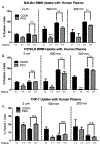PEGylation of model drug carriers enhances phagocytosis by primary human neutrophils
- PMID: 30195083
- PMCID: PMC6181144
- DOI: 10.1016/j.actbio.2018.09.001
PEGylation of model drug carriers enhances phagocytosis by primary human neutrophils
Abstract
Targeted drug carriers are attractive for the delivery of therapeutics directly to the site of a disease, reducing systemic side effects and enhancing the efficacy of therapeutic molecules. However, the use of particulate carriers for drug delivery comes with its own set of challenges and barriers. Among these, a great deal of research effort has focused on protecting carriers from clearance by phagocytes via altering carrier surface chemistry, mostly with the use of polyethylene glycol (PEG) chain coatings. However, few papers have explored the effects of PEGylation on uptake by freshly-obtained primary human phagocytes in physiological conditions. In this work, we investigate the effect of PEGylation on particle uptake by primary human neutrophils in vitro and compare these effects to several cell lines and other model phagocytic cells systems. We find that human neutrophils in whole blood preferentially phagocytose PEGylated particles (e.g., ∼40% particle positive neutrophils for PEGylated versus ∼20% for carboxylated polystyrene microspheres) and that this effect is linked to factors present in human plasma. Model phagocytes internalized PEGylated particles less efficiently or equivalently to carboxylated particles in culture medium but preferentially phagocytosed PEGylated particles in the human plasma (e.g., ∼86% versus ∼63% PEGylated versus carboxylated particle positive cells, respectively). These findings have significant implications for the efficacy of PEGylation in designing long-circulating drug carriers, as well as the need for thorough characterization of drug carrier platforms in a wide array of in vitro and in vivo assays.
Statement of significance: The work in this manuscript is highly significant to the field of drug delivery, as it explores in-depth the effects of polyethylene glycol (PEG) coatings, which are frequently used to prevent phagocytic clearance of particulate drug carriers, on the phagocytosis of such carriers by neutrophils, the most abundant leukocyte in blood circulation. Surprisingly, we find that PEGylation enhances uptake by primary human neutrophils, specifically in the presence of human plasma. This result suggests that PEGylation may not confer the benefits in humans once thought, and may help to explain why PEG has not become the "magic bullet" it was once thought to be in the field of particulate drug delivery.
Keywords: Microparticles; Nanoparticles; Neutrophils; Opsonization; PEGylation; Particle drug carriers; Phagocytosis.
Copyright © 2018 Acta Materialia Inc. Published by Elsevier Ltd. All rights reserved.
Figures






References
Publication types
MeSH terms
Substances
Grants and funding
LinkOut - more resources
Full Text Sources
Other Literature Sources
Research Materials

